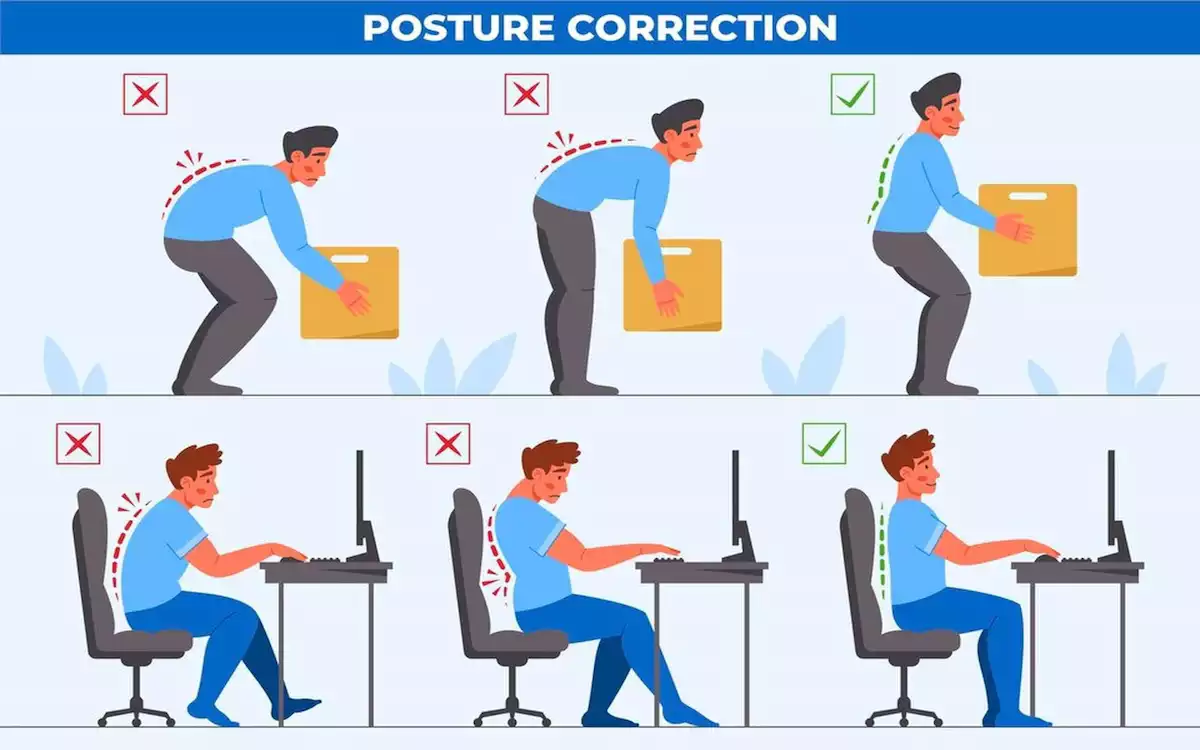Being healthy starts with having good posture, which is more than just standing tall. A lot of people slouch or hunch over without realizing it, especially when they sit at a desk for hours on end, work on their laptops, or scroll through their phones.
If you don’t take care of your posture, it can cause neck and back pain, joint problems, tiredness, and even a drop in your lung capacity over time. To fix your posture, you don’t need a gym or any fancy gear. With easy, effective exercises you can do at home, you can retrain your muscles and slowly get your body back to its natural position.
Understanding Posture: What It Means And Why It Matters
When you stand, sit, or move, your posture is how you hold your body. Your body should be aligned in a way that puts the least amount of stress on your muscles and ligaments. This alignment can be thrown off by bad habits like slouching in your chair or tilting your head forward.
These are some common reasons why people have bad posture:
- Sitting for long periods, especially with bad ergonomic support
- Lack of back and core strength
- imbalances and tightness in the muscles
- Not moving enough
If you don’t fix your posture, it can cause long-term pain, tension headaches, tiredness, digestive problems, and a smaller range of motion. To fix it, you need to stretch out muscles that are tight and strengthen the muscles that support good posture.
Key Muscles Involved In Posture Maintenance
A healthy posture requires a lot of different muscle groups to work together. Knowing about them helps you focus your efforts well:
- The lower back, obliques, and abdominal muscles make up the core. They support the spine and pelvis.
- The trapezius and rhomboid muscles in your upper back. They keep your shoulders straight and your chest open.
- Shoulder and neck muscles are very important for keeping your head in the right place and your spine straight.
- Tight or weak hips can tilt your pelvis and put your spine out of place.
When these muscles are strong and flexible, they help you stand up straight and take stress off of your joints and ligaments.
Pre-exercise Tips: Preparing Your Body For Posture Workouts
- Warm-up: To get the blood flowing, do light cardio for 5 to 10 minutes, like walking in place or in arm circles.
- Breathing: To practice diaphragmatic breathing, breathe in deeply via your nose, let your belly develop, and slowly breathe out through your mouth. This makes you more aware of how your spine and rib cage are aligned.
- Set up your space: For comfort, use a yoga mat or a towel. Make sure you have enough room to move around and a wall nearby for exercises that use support, like wall angels.
Top 10 Home Exercises To Improve Posture
Wall Angels
Place your back flat against a wall and bend your arms 90 degrees. Lift and lower your arms slowly while keeping your hands on the wall. This works out the muscles in your upper back and shoulders, which improves your alignment and posture by straightening out shoulders that are rounded from slouching or sitting for long periods.
Cat-Cow Stretch
Switch between arching your back (cat) and lowering your belly while lifting your head (cow) while you’re on all fours. This move makes your spine more flexible, eases stiffness, and makes you more aware of how your back is aligned. It’s great for moving the spine and easing tension in the lower back and neck.
Plank
Hold your body straight on your forearms and toes, and squeeze your shoulders, glutes, and core. Planks build core strength and stability, which are important for keeping your back straight. Stay in good form during the whole hold by keeping your spine straight and not sagging or arching.
Glute Bridges
Lay on your back with your feet flat and your knees bent. Squeeze your glutes to lift your hips and make a straight line from your shoulders to your knees. This makes the glutes and lower back stronger, which helps with back pain and bad posture caused by tight hip flexors and an anterior pelvic tilt.
Shoulder Blade Squeeze
Hold your shoulder blades together for five seconds, then let go. You can sit or stand tall. Do it 10–15 times. This makes the rhomboids and upper back muscles stronger, which helps pull your shoulders back and stop your shoulders from rounding forward from slouching or bad computer posture.
Chest Opener Stretch
Straighten your arms, clasp your hands behind your back, and lift your chest slowly. This loosens up pectoral muscles that are tight and tend to pull the shoulders forward. The chest opener helps you position your shoulders better and stops you from hunching, which is useful for people who sit for long times.
Child’s Pose
Get down on your knees, sit back on your heels, and reach your arms out in front of you on the ground. Put your forehead down on the ground. This pose is good for healing because it gently stretches the spine, eases tension in the lower back, and helps the spine return to its natural curve by making the back muscles longer and more relaxed.
Bird Dog
Get down on your knees and hands. Keep your back flat and stretch out your right arm and left leg. Hold and then switch sides. This move strengthens the core and improves balance. It also teaches the spine to stay neutral while moving, which is important for building strong muscles that support your posture and better coordination.
Chin Tucks
Pull your chin back straight as if you were making a “double chin.” You can do this while sitting or standing. Hold for five seconds, then do it again. For people who spend a lot of time in front of a screen, this strengthens the deep neck flexors and fixes forward head posture. It helps keep the head straight over the spine, which reduces neck strain.
Thoracic Extension On Foam Roller
Lay on your back and put a foam roller or a towel that has been rolled up under your upper back. Hold your head up and gently arch your back. This stretches the thoracic spine, which makes the middle back more flexible and less stiff. It helps get your spine back to its natural curves and undoes the damage done by long hours of slouching or working at a desk.
Conclusion
You don’t need to spend a lot of money on a gym membership or follow a complicated workout plan to improve your posture. All you need is dedication, body awareness, and a few simple exercises you can do at home. You can fix postural imbalances and get benefits like less pain, better breathing, and more confidence by working out the right muscles, making healthy daily habits, and sticking to them. Every time you stretch, squeeze, or do a plank, your back will thank you.




 Importance of Hydration for Your Brain, Body, and Everyday Energy
Importance of Hydration for Your Brain, Body, and Everyday Energy  Healthiest Breakfast Cereal for Children
Healthiest Breakfast Cereal for Children  Anxiety Management Techniques
Anxiety Management Techniques  What Makes Fat in Our Body?
What Makes Fat in Our Body?  Best Diet to Reduce Risk of Diabetes
Best Diet to Reduce Risk of Diabetes  Long Term Effects from Botox
Long Term Effects from Botox